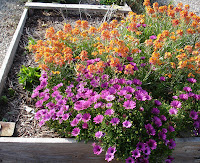Despite their thorns, roses are the most popular flower. The rose has been a symbol of romance for decades. Roses are popular because of their beauty and fragrance, they are relatively hardy and easy to grow, they don't have to be replanted every year, many are repeat bloomers, and they come in many colors. There are probably many more reasons, but look for yourself at some of the roses growing in my garden and see if you don't agree that roses are wonderful.
Mr. Lincoln: On of the all time favorite garden roses. Mr. Lincoln has velvety deep red petals and is a hybrid tea. Strongly scented flowers are held upright on stiff stems, and flowers are good for cutting. This one is growing along the drive into the gardens. Red roses are a symbol of beauty, romantic love, courage and passion.

Cecile Brunner: Nicknamed the 'Sweetheart Rose', this polyantha has perfectly formed tiny pink buds with 18 petals. Cecile Brunner was developed in 1894 and is lightly fragrant, a once-blooming climber in my garden although it is often sold as a continuous bloomer. Dainty flowers and an aggressive vine which will grow to 20 to 30 feet. If you want to cover an arbor quickly but are willing to do lots of pruning at the end of the year, this one is for you. Cecile is growing on the rose arbor. Pink is a symbol of elegance, gracefulness, appreciation, and says thank you.

Midas Touch: A beautiful hybrid tea yellow rose almost golden in the sunlight with 17 to 25 petals and bred in the United States in 1992. Midas Touch has 4 inch blooms in flushes throughout the season and has a warm musky scent. Midas is growing near Mr. Lincoln along the drive into the gardens. Yellow roses are a symbol of youth, happiness, friendship, a new beginning, and are given to remind the receiver of the sender.

Angle Face: A strong citrus scented lavender floribunda, cluster flowered, developed in the United States in 1968. Blooms are 3 inches in diameter with ruffled petals. Climbing Angle Face is along the driveway and upright Angle Face is under the ash tree. Lavender roses are a symbol of love at first sight and enhandement.

Devoniensis: An old fashioned climber from the United Kingdom developed in 1858. Known as the magnolia rose, this fragrant, repeat bloomer has a strong tea scent. The blooms are soft cream colored and about 4 inches in diameter. This rose is growing on the left side of the potting shed.

Sombreuil: Another old fashioned climber from France developed in 1850. Fragrant fairly strong tea scent, creamy white flowers and a repeat bloomer. This one is growing on the right side of the potting shed. White roses are a symbol of purity, innocence, humility, youthfulness, sincerity and unity.

Joseph's Coat: An slightly fragrant orange climber developed in the United States in 1964. Joseph's Coat blooms open yellow orange then change to red and gold. The rose is disease resistant, has 20 or more petals and blooms continuously with hanging clusters. Joseph's Coat is growing on the re-bar arbor near the perennial border. Orange roses symbolize enthusiasm and desire.

The roses will be blooming over the next several weeks. I have over 50 roses growing in the gardens and some of the roses were planted by a previous owners. I would like to identify each rose, so if you see a rose and know its name, please let me know. Hope to see you soon.
 I am proud to announce the Springville Park will be open this weekend for the annual Jackass Mail Run. My garden group, Springville Garden Friends, volunteered to plant the clock tower bed for the park today. You'll see a few candid shots taken by Phyllis of our garden group hard at work this morning at the clock tower.
I am proud to announce the Springville Park will be open this weekend for the annual Jackass Mail Run. My garden group, Springville Garden Friends, volunteered to plant the clock tower bed for the park today. You'll see a few candid shots taken by Phyllis of our garden group hard at work this morning at the clock tower. 
 Phyllis took some wonderful photos of us. After we dug in the dirt, we all congregated at Springville Lavender Gardens with a brown bag lunch, imbibed in some lavender lemonade and some well deserved relaxation under the wisteria pergola.
Phyllis took some wonderful photos of us. After we dug in the dirt, we all congregated at Springville Lavender Gardens with a brown bag lunch, imbibed in some lavender lemonade and some well deserved relaxation under the wisteria pergola.
























